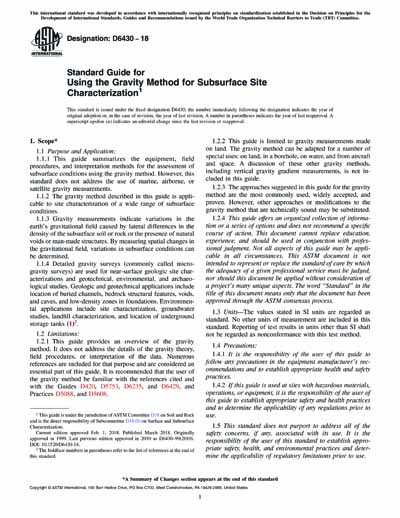Most recent
ASTM D6430-18
Standard Guide for Using the Gravity Method for Subsurface Site Characterization
1.1 Purpose and Application:
1.1.1 This guide summarizes the equipment, field procedures, and interpretation methods for the assessment of subsurface conditions using the gravity method. However, this standard does not address the use of marine, airborne, or satellite gravity measurements.
1.1.2 The gravity method described in this guide is applicable to site characterization of a wide range of subsurface conditions.
1.1.3 Gravity measurements indicate variations in the earth's gravitational field caused by lateral differences in the density of the subsurface soil or rock or the presence of natural voids or man-made structures. By measuring spatial changes in the gravitational field, variations in subsurface conditions can be determined.
1.1.4 Detailed gravity surveys (commonly called microgravity surveys) are used for near-surface geologic site characterizations and geotechnical, environmental, and archaeological studies. Geologic and geotechnical applications include location of buried channels, bedrock structural features, voids, and caves, and low-density zones in foundations. Environmental applications include site characterization, groundwater studies, landfill characterization, and location of underground storage tanks (1)2.
1.2 Limitations:
1.2.1 This guide provides an overview of the gravity method. It does not address the details of the gravity theory, field procedures, or interpretation of the data. Numerous references are included for that purpose and are considered an essential part of this guide. It is recommended that the user of the gravity method be familiar with the references cited and with the Guides D420, D5753, D6235, and D6429, and Practices D5088, and D5608.
1.2.2 This guide is limited to gravity measurements made on land. The gravity method can be adapted for a number of special uses: on land, in a borehole, on water, and from aircraft and space. A discussion of these other gravity methods, including vertical gravity gradient measurements, is not included in this guide.
1.2.3 The approaches suggested in this guide for the gravity method are the most commonly used, widely accepted, and proven. However, other approaches or modifications to the gravity method that are technically sound may be substituted.
1.2.4 This guide offers an organized collection of information or a series of options and does not recommend a specific course of action. This document cannot replace education, experience, and should be used in conjunction with professional judgment. Not all aspects of this guide may be applicable in all circumstances. This ASTM document is not intended to represent or replace the standard of care by which the adequacy of a given professional service must be judged, nor should this document be applied without consideration of a project's many unique aspects. The word “Standard” in the title of this document means only that the document has been approved through the ASTM consensus process.
1.3 Units—The values stated in SI units are regarded as standard. No other units of measurement are included in this standard. Reporting of test results in units other than SI shall not be regarded as nonconformance with this test method.
1.4 Precautions:
1.4.1 It is the responsibility of the user of this guide to follow any precautions in the equipment manufacturer's recommendations and to establish appropriate health and safety practices.
1.4.2 If this guide is used at sites with hazardous materials, operations, or equipment, it is the responsibility of the user of this guide to establish appropriate safety and health practices and to determine the applicability of any regulations prior to use.
1.5 This standard does not purport to address all of the safety concerns, if any, associated with its use. It is the responsibility of the user of this standard to establish appropriate safety, health, and environmental practices and determine the applicability of regulatory limitations prior to use.
1.6 This international standard was developed in accordance with internationally recognized principles on standardization established in the Decision on Principles for the Development of International Standards, Guides and Recommendations issued by the World Trade Organization Technical Barriers to Trade (TBT) Committee.
Content Provider
ASTM International [astm]






